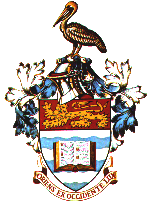![]()
![]()
![]()
![]()
![]()

![]()
![]()
![]()
![]()
![]()
Auxotrophic mutations have been used extensively in studies of microorganisms as they can be readily detected visually by using a replica plating technique. So the organism can be treated with a mutagen and the survivors can be plated out on a medium containing particular nutrients. These ‘master' plates can be replicated by a number of means (such as needles or velvet) onto minimal medium. Colonies on the master plate that don't grow on MM are auxotrophic for the nutrient or one of the nutrients in the master plate. Consequently generalised screens for auxotrophs can be performed or direct screens for particular nutritional requirements.
E.g.
i) Survivors plated onto complete medium, replicate on MM: a range of auxotrophic mutants can be isolated which then have to be screened to determine individual requirements.
ii) Survivors plated onto MM + pyridoxine, replicated onto MM: allows direct isolation of pyridoxine auxotrophs (pyr– ).
iii) survivors plated on MM + all vitamins, replicated onto MM: isolate vitamin auxotrophs.
iv) to isolate amino acid auxotrophs: plate survivors onto MM + all amino acids, replicate onto MM
v) To isolate nucleotide auxotrophs (mutants in pyrimidine or purine biosynthesis): plate survivors onto MM + DNA
Note that mutations are pre-adaptive or non-adaptive: occur by chance rather than occurring in response to the environmental stress. So penicillin degrading mutants do not arise because they are in a penicillin-containing medium, but if mutants are in the culture before penicillin is added, they will grow.
The principle behind enrichment techniques is that conditions are provided so that the normal function of the wild type strain works against its survival
A crude technique is used with conidia-forming filamentous fungi e.g. Aspergillus and Neurospora. Wild type strains will grow in liquid MM whereas auxotrophic strains will not grow. The mutagenised culture can be transferred to liquid MM, the wild type prototrophs will germinate and can be filtered out using sterile cheesecloth. After several rounds of growth and filtration the ungerminated auxotrophic spores will be left in suspension. These can be harvested by centrifugation, plated out on supplemented medium (medium containing supplements) and replicated as before.
Another example of enrichment technique is penicillin enrichment originally used with E. coli. Penicillin kills bacteria by inhibiting cell wall synthesis during growth. Cells which grow in the presence of penicillin undergo lysis and die. Auxotrophic cells in a mutagenised culture tend to survive in liquid MM + penicillin because they do not start to grow. The growing prototrophs become lysed by the presence of penicillin and the surviving auxotrophs are then recovered by centrifugation, washed to remove penicillin or treated with penicillinase or -lactamase (important, else penicillin still present adhered to cells) and plated on supplemented medium.
Similar approaches can be devised for selecting other types of mutants. Toxic analogues of important compounds can be used to detect mutants which do not take up or metabolise the normal non-toxic form. For example, toxic amino acid analogues such as 4-methyltryptophan, p-fluorophenylalanine and canvanine which mimic tryptophan, phenylalanine and arginine, respectively can be used to select mutants of bacteria and fungi that are defective in their ability to concentrate the normal amino acid forms from the growth medium.
Non-mutants which can take up and metabolise these analogues will be killed while mutants defective in their ability to take up or metabolise the chemicals will live. These can then be harvested, washed and plated out.
In Drosophila, incorporation of certain secondary alcohols such as pentanol automatically selects for larvae deficient in alcohol dehydrogenase (Adh), since this enzyme catalyses oxidation of alcohols into the corresponding aldehydes. Oxidation products of secondary alcohols are highly toxic to the larvae, so only those Adh–larvae survive. They can then be transferred to non-toxic medium and analysed.
In mammalian cell cultures toxic nucleoside analogues can be incorporated in the medium. These include:
i) Bromodeoxyuridine, a thymidine analogue which is toxic in (wild type) cells producing thymidine kinase (adds phosphates to make TTP), but are harmless otherwise. Isolation of tk– mutants is thus possible.
ii) Diamopurine, an adenine analogue for isolation of adenine phosphoribosyl transferase (APRT) mutants (aprt– ).
We have looked at mutants that are deficient in a particular function, but some mutants also confer apparent gains in function.
e.g. B-galactosidase in E. coli which is produced onlyresponse to lactose (or suitable analogue) in the medium. Certain mutants (Oc) produce this enzyme at high levels under all conditions.
In photosynthetic cells a number of specific defects in the photosynthetic apparatus are known: they can be positively selected as they confer resistance to arsenate which is toxuc for photosynthesising cells. This is a maternally inherited mutation as it is carried in the chloroplast DNA.
This template created by the Web Diner.